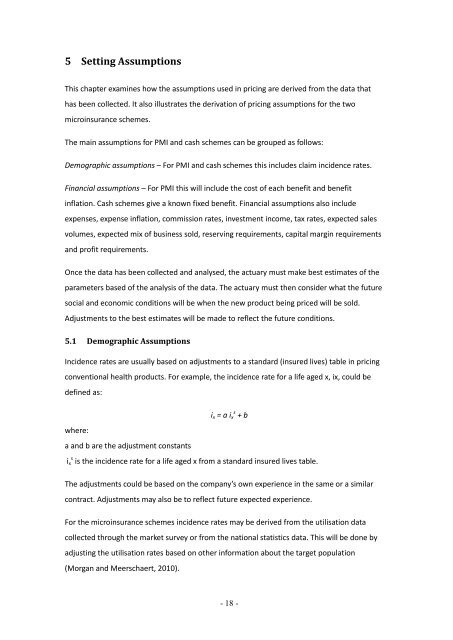Sample Dissertation Format - Scor
Sample Dissertation Format - Scor
Sample Dissertation Format - Scor
You also want an ePaper? Increase the reach of your titles
YUMPU automatically turns print PDFs into web optimized ePapers that Google loves.
5 Setting Assumptions<br />
This chapter examines how the assumptions used in pricing are derived from the data that<br />
has been collected. It also illustrates the derivation of pricing assumptions for the two<br />
microinsurance schemes.<br />
The main assumptions for PMI and cash schemes can be grouped as follows:<br />
Demographic assumptions – For PMI and cash schemes this includes claim incidence rates.<br />
Financial assumptions – For PMI this will include the cost of each benefit and benefit<br />
inflation. Cash schemes give a known fixed benefit. Financial assumptions also include<br />
expenses, expense inflation, commission rates, investment income, tax rates, expected sales<br />
volumes, expected mix of business sold, reserving requirements, capital margin requirements<br />
and profit requirements.<br />
Once the data has been collected and analysed, the actuary must make best estimates of the<br />
parameters based of the analysis of the data. The actuary must then consider what the future<br />
social and economic conditions will be when the new product being priced will be sold.<br />
Adjustments to the best estimates will be made to reflect the future conditions.<br />
5.1 Demographic Assumptions<br />
Incidence rates are usually based on adjustments to a standard (insured lives) table in pricing<br />
conventional health products. For example, the incidence rate for a life aged x, ix, could be<br />
defined as:<br />
where:<br />
a and b are the adjustment constants<br />
ix = a ix s + b<br />
ix s is the incidence rate for a life aged x from a standard insured lives table.<br />
The adjustments could be based on the company’s own experience in the same or a similar<br />
contract. Adjustments may also be to reflect future expected experience.<br />
For the microinsurance schemes incidence rates may be derived from the utilisation data<br />
collected through the market survey or from the national statistics data. This will be done by<br />
adjusting the utilisation rates based on other information about the target population<br />
(Morgan and Meerschaert, 2010).<br />
- 18 -

















